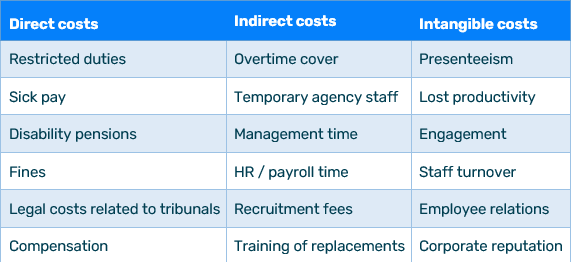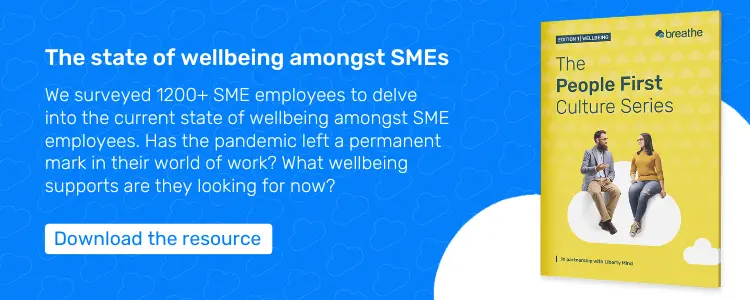The importance of health and safety in the workplace simply cannot be underestimated. As well as being the law, it is part and parcel of being a good employer to make sure your staff aren’t at risk of any injury as a result of the work they do for you.
It’s not just your staff that health and safety is important for, either. Health and safety precautions are there to protect any visitors, customers, sub-contractors and the general public who may work for you, do business with you or come into contact with your organisation in any way.
Jump to:
Why is health and safety at work important?
Health and safety is important because it protects your employees and any visitors to your business, such as clients or customers.
Employers have a duty of care to ensure a safe working environment under the Health and Safety at Work Act 1974, but more than that, it’s good business practice to adhere to health and safety laws. Businesses that flout the law face losing staff, higher recruitment costs, lower retention rates and lower profitability.

Worse still, poor health and safety can lead to illness, injury and even death - you can be prosecuted for breaching health and safety regulations which can lead to fines, imprisonment and the loss of your business altogether.
Workplace health and safety is important for the health and wellbeing of all employees across all industries. And the last thing you want is to be the employer who loses an employee in an accident and is then charged with corporate manslaughter.
What is the Health and Safety at Work Act?
The Health and Safety at Work Act 1974 (HSWA) is the piece of legislation which enshrines the general principles of health and safety in the workplace.
It places a wide range of duties on the employer to take all measures “so far as is reasonably practicable” to prevent or reduce risk in the workplace.
The Health and Safety Executive (HSE) is responsible for enforcing the HSWA along with local authorities.
Read more about the HSWA in our jargon-free guide to health and wellbeing in the workplace.
Employer's responsibilities under the Act
To avoid heavy fines from health and safety breaches, it's vital that HR consultants, line managers and SMEs regularly check legislation revisions and updates to ensure that they stay on track and in the HSWA's good books.
The HSWA places a wide range of duties on the employer to protect the health and safety of their:
- workers and direct employees;
- temps and casual staff;
- sub-contractors and freelancers;
- clients and partners; plus
- visitors and the general public when they’re on the business' premises.
Employers have a duty of care to take all steps “so far as is reasonably practicable” to protect anyone connected to their business.
Alongside the HSWA regulations, you'll find government-issued guides and codes of practice that details responsibilities, covering everything from heavy lifting to control of hazardous substances.
The Health and Safety Executive was set up under the HSWA to ensure the provisions of the Act are met and there is a risk of fines and criminal penalties if the law is breached.
Providing a safe workplace

Health and safety in the workplace is a shared responsibility. While employees play a part - find out what employees are responsible for - it's up to employers to make sure the workplace is safe for everyone.
This effectively means you need to make sure your workers are protected from anything that could cause them harm or injury at work.
Employers need to control workplace risks and take all reasonable steps to eliminate or minimise them. This means regularly:
- undertaking risk assessments;
- providing essential information about the risks; and
- ensuring there is adequate instruction and training for how employees and managers can deal with those risks.
If you run a factory, this could mean providing the right safety equipment and training for operating machinery as well as putting procedures in place to control and monitor the use of any hazardous substances used in the course of your business.
In an office, we're more likely to see guidelines for ensuring emergency exits are marked and that staff know what to do in the event of a fire or accident.
Although the legal responsibility sits with employers, employees also need to do their part - by following procedures, using equipment safely, and speaking up if they spot something that doesn't seem right.
A culture of shared responsibility means everyone's more likely to go home safe, every day.
Employee health and wellbeing

An employer’s duty of care doesn’t just apply to safety. It includes all aspects of their health and wellbeing, including mental health. As well managing day-to-day risks, check that your staff are:
- not working excessive hours;
- protected from bullying and harassment;
- free from discrimination; and
- aware of who to turn to when raising any concerns.
Keeping a grip on these issues isn’t just a legal duty, but also great business practice. There is a strong argument for supporting employees as much as you can to improve productivity as well as reduce staff turnover, sickness absence and presenteeism.
Richard Holmes, a partner of The Working Health Company, told a conference on health and wellbeing in 2017 suggested employees could gain almost a day week in terms of productivity if employers focussed on health and wellbeing.
And in another 2018 poll, an overwhelming 97% of decision-makers agreed employee happiness leads to greater productivity.
The cost of bad health and safety

If your business' health and safety regime is poor, you're at risk of breaching HSWA legislation as well as seeing more absences from staff illness.
Severe breaches can lead to serious injury, illness or even death. Aside from the horror of such scenarios, you as an employer, could be held liable for the breaches and fined or even face a jail term. The long-term effects on a business can include:
-
hefty legal costs;
-
expensive insurance premiums;
-
reputation in ruins;
-
drops in revenue; and
-
even closure.
Millions of days of work are lost each year as a result of workplace illness and injury and thousands of people die from occupational illnesses. According to the HSE, 1.4 million workers suffered from a work-related illness in 2017/2018 and 144 workers were killed.
Statistics also reveal 30.7 million days were lost to workplace illness and injury, and the cost to the economy for such injuries in 2016/17 was around £15 billion.
Work-related illness and injury can not only impact their quality of life, but it can also financially damage your business, impact your productivity and harm your reputation. These are all things that can be quite difficult to recover from.
The statistics are sobering in themselves but it’s perhaps the human stories which really bring home the tragedy of poor health and safety.
Examples of poor health and safety at work
In summer 2015, a number of riders on the Smiler roller coaster at Alton Towers suffered serious injuries when it crashed into other cars on the track.
Not only was the impact on them severe and life-changing with several undergoing amputations, but HSE investigators found the main cause to be a lack of robust health and safety measures in place to stop staff making errors which led to the crash.
As a result, parent company Merlin Entertainments was fined a record £5 million. Alton Towers subsequently suffered a slump in trade and profits, which forced the company to ask the Government for a review of its £4 million annual rates bill in the ensuing years.
A food manufacturer in Telford was fined £10,000 and ordered to pay £5,614 in costs after a cleaner’s fingers were severed when he tried to pull a piece of raw potato from a pipe. An HSE investigation found the guard on the machine had not been properly maintained.
An energy company had to pay more than half a million pounds when a worker fell to his death from a power station in Wales. The HSE investigation found a large open walkway had been left unprotected after floor gratings had been removed and that inadequate precautions were taken to protect staff working in the vicinity.
How you can promote good health and safety in the workplace
Dealing with health and safety can seem tedious. On the face of it, it can feel a bit like form filling rather than doing what you really love, namely driving your business forward. But it’s an essential part of any good business and needn’t be onerous.
1. Have a written policy
Under the HSWA you only need a written policy if you have five or more employees. However, it’s good practice to have a written one even if you don’t employ many people because it makes you properly risk assess your business and put measures in place to control them. It will contain a general statement on health and safety and how you intend to manage it, it will detail who is responsible for health and safety in your organisation and it will cover the risks to your business and what you have done to mitigate or eliminate them. The policy should be reviewed annually or more often where necessary.
2. Have a proper training programme
Make sure all staff are trained in health and safety. Make it part of their induction so they’re aware from the moment they join that it’s to be treated as a priority. You should also review this regularly and staff should have regular refresher training or when any new policies are implemented.
HR software such as Breathe allows you to easily monitor training and securely store documents. Start your free 14 day trial here.
3. Get the right equipment
Having a health and safety policy is a big step in the right direction, but you also need to make sure you’re following through on managing those risks. Make sure your staff have the equipment they need to do their jobs properly and safely. It’s also important to have the right signage and training so equipment is used correctly and reduces the risk of errors occurring.
4. Lead from the top down
Good health and safety comes from the top. If you let things slide so will your staff, so it’s important you stay on top of safety matters. Make sure your staff all have regular training and that you stay up to date with the latest news and changes in the law. If you take a proactive approach to health and safety, you’ll build a relationship as a caring and conscientious employer and your staff will follow suit.
5. Offer an Occupational Health Scheme
Should your employees need support or further assessment after an accident at work, an injury or an illness, Occupational Health practitioners are qualified to help in such situations. Working closely with HR, outsourcing to an organisation which specialises in Occupational Health, protects everybody.
What is Occupational Health?

Occupational Health is a specialist branch of medicine that focuses on the physical and mental wellbeing of employees in the workplace. Occupational practitioners are medical and healthcare professionals (mostly doctors and nurses) with specialist areas of expertise.
They work with the people responsible for HR and people management in organisations of every size to provide impartial advice that supports employees and helps employers understand people’s issues.
HR and business managers then use this information to develop programs such as Employee Assistance Plans which support people who may be at risk, are suffering from existing issues or returning to work after a period of absence.
By engaging with Occupational Health practitioners, businesses can take both a proactive and reactive approach to employee health and safety which, in turn, reduces absences, increases engagement and boosts productivity.
What can Occupational Health provide to employers?
Is Occupational Health for SMEs or large organisations?
It’s for both. Yes, there are costs associated with Occupational Health practitioners and at a time when many smaller companies in particular are struggling with cash-flow, these may seem like an unnecessary financial burden. But the reality is, occupational health can help businesses reduce costs and ensure their people are working happily and productively at a time when their efforts are so key to business recovery.
The business case for Occupational Health
Prior to the pandemic taking hold, the Society of Occupational Medicine (SoM) published a report which built the case for Occupational Health demonstrating the value it can bring. Helpfully, SoM’s report lists the direct and indirect costs associated with sickness absences, which is something often overlooked by companies.

To understand Occupational Health and its relevance to UK small businesses in the current circumstances, we talked to Sally White, Director of SYLO Beyond HR, an award-winning provider of HR and People Support services. This includes not only ensuring the wellbeing of the employees but also providing support for employers too.
Sally White comments: “By engaging with occupational health professionals to support employees, businesses can avoid many of the costs related to absenteeism, especially in cases where an employee is on long-term sick-leave.
“Although there are costs associated with investing in Occupational Health, these are often a fraction of what businesses need to spend if employee physical and mental problems go unchecked. Monitoring and really understanding absences has always been important but probably never more so than now.”
Recording health-related documents
Sally also recommends that business managers use a system like Breathe to record and store documents related to Occupational Health related assessments. This is key for effective absence monitoring and helps form a platform for fact based, and supportive discussions with employees.
“Not only is it good practice to store all employees related information securely in a single place, it means directors will have easy access to information if, unfortunately, a dispute arises. In effect, employers can create and store an audit-trail of all documents and communications which can be easily referenced at any time,” she concludes.
The benefits of health and safety in the workplace far outweigh any frustrations
Sometimes health and safety can feel like ‘red tape’, but there are plenty of benefits of maintaining good health in the safety in the workplace, including:
-
fewer accidents
-
clear guidelines so employers and employees know what to do, and when
-
less of a threat of potential legal action
-
reduced costs and risks
…and much, much more. For starters, the greatest benefit of health and safety is that it helps safeguard your employees’ health and wellbeing.
Frequently asked questions on workplace health & safety
Do I need an emergency plan for my workplace?
Yes. Being ready for emergencies is an essential part of keeping your people safe. Whether it’s a fire, a power cut, or a medical incident, having a plan, and practicing it, can make all the difference.
Your plan should cover:
-
Evacuation procedures – including clear meeting points and regular drills
-
First aid arrangements – with trained first aiders and fully stocked kits
-
Incident reporting – so you can learn from what’s happened and help prevent future risks
-
Communication steps – to keep your team informed and contact emergency services quickly
Looking for more ways to support your team’s health and wellbeing?
Well look no further. From understanding how to improve health and safety in the workplace to discovering how you can continue supporting your team’s health and wellbeing, we’re here to help.
Explore our guides to health and wellbeing in the workplace today, or take a look at our latest investigation into the state of wellbeing amongst SME employees, below.
.webp)
Author: Sarah Benstead
Sarah is a Product Marketing Specialist here at Breathe. Always innovating, she loves writing about product releases in an engaging & informative way. When she's not coming up with new ideas, she enjoys long walks with her dog, Clifford.


-min.png?width=680&name=Occupational%20health%20table%201%20(1)-min.png)



